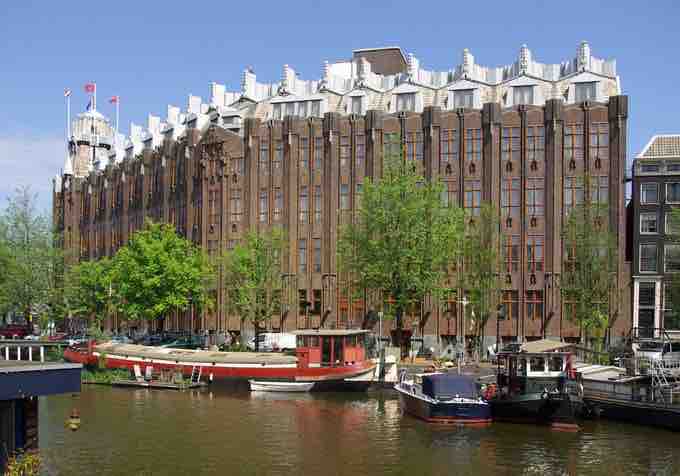The Amsterdam School (Dutch: Amsterdamse School) is a style of architecture that arose in 1910 and lasted until about 1930 in The Netherlands. The Amsterdam School movement is considered to be part of international Expressionist architecture, sometimes linked to German Brick Expressionism. Buildings of the Amsterdam School are characterized by their use of bricks, rounded or organic appearance, relatively traditional massing, and the integration of an elaborate scheme of building elements inside and out such as decorative masonry, art glass, wrought ironwork, spires or "ladder" windows (with horizontal bars), and integrated architectural sculpture. The aim was to create a total architectural experience, interior and exterior.
Imbued with socialist ideals, the Amsterdam School style was often applied to working-class housing estates, local institutions and schools. For many Dutch towns, Hendrik Berlage designed the new urban schemes, while the architects of the Amsterdam School were responsible for the buildings. With regard to the architectural style, Michel de Klerk had a different vision than Berlage. In the magazine "Bouwkundig Weekblad 45/1916," Michel de Klerk criticized Berlage's recent buildings in the style of Dutch Traditionalism. In this context, the Stock Exchange by Berlage of 1905 can be seen as the starting point of traditionalist architecture.
The Amsterdam School had its origins in the office of architect Eduard Cuypers in Amsterdam. Although Cuypers was not a progressive architect himself, he gave his employees plenty of opportunity to develop. The three leaders of the Amsterdam School Michel de Klerk, Johan van der Mey, and Piet Kramer all worked for Cuypers until about 1910. In 1905, Amsterdam was the first city to establish a building code, and the city hired Johan van der Mey afterwards, in the special position as "Aesthetic Advisor," to bring artistic unity and vision to its built environment. Van der Mey's major commission, the 1912 cooperative-commercial Scheepvaarthuis (Shipping House), is considered the starting point of the movement, and the three of them collaborated on that building.The movement and its followers played an important role in Berlage's overall plans for the expansion of Amsterdam.

The Scheepvaarthuis, Amsterdam.
The 1912 cooperative-commercial Scheepvaarthuis (Shipping House) is considered the starting point of the Amsterdam School movement.
The most important architects and virtuoso artists of the Amsterdam School were Michel de Klerk and Piet Kramer. Other members included Jan Gratama (who gave it its name), Berend Tobia Boeyinga, P. H. Endt, H. Th. Wijdeveld, J. F. Staal, C. J. Blaauw, and P. L. Marnette. The journal Wendingen ("Windings" or "Changes"), published between 1918 and 1931, was the magazine of the Amsterdam School movement.
After De Klerk died in 1923, the style lost its importance. The De Bijenkorf Store in the Hague by Piet Kramer of 1926 is considered to be the last example of "classic" Amsterdam School Expressionism.